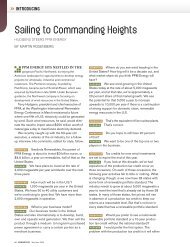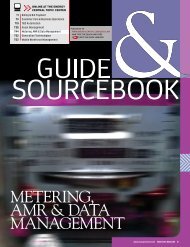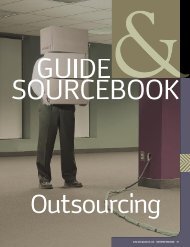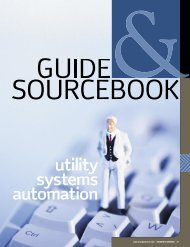asset management
asset management
asset management
You also want an ePaper? Increase the reach of your titles
YUMPU automatically turns print PDFs into web optimized ePapers that Google loves.
A D V EE RR TT II SS E M E N T<br />
[ C A S E S T U D Y ]<br />
To put it simply, the Toughbook implementation has helped<br />
British Gas achieve unusually high customer-satisfaction levels<br />
— the Holy Grail of all enterprises trying to increase market share,<br />
profits and ROI via new business acquisition and retention.<br />
Another utility company that has used cutting-edge mobile computing<br />
and communications technology to lead its industry in customer<br />
satisfaction is Arizona’s Salt River Project, recipient of the 2004 J.D.<br />
Power and Associates Distinction for Electric Utilities Award.<br />
SRP, which uses fully ruggedized Panasonic notebooks such<br />
as the Toughbook CF-29—a MIL-STD-810F-tested, Centrino-compliant<br />
portable—reports that increased use of rugged portable<br />
computers in the field has resulted in substantial savings in both<br />
dollars and personnel hours.<br />
And, SRP says, those are only some of the benefits attributable<br />
to the Toughbook deployment. Others include increased work crew<br />
efficiency, better communications and scheduling, safety improvements<br />
related to having the most current electric maps available<br />
for each job, safety improvements related to a decrease in miles<br />
driven to obtain maps and support at field offices, decreased radio<br />
and cell-phone traffic, an increase in customer service quality and<br />
a decrease in the amount of time customers are out of service.<br />
Since SRP’s corporate culture orbits around customer service,<br />
the last two items on that very impressive laundry list are arguably<br />
the most important. The company’s 2004 rating of 112 on J.D.<br />
Power’s utility customer satisfaction list outranked that of every<br />
other electricity supplier in the U.S., and company officials plan to<br />
do at least that well this year.<br />
SRP managers attribute a good part of their long-term customer<br />
honeymoon to the company’s policy of constantly upgrading and<br />
updating their mobile computing capability, adding applications<br />
and enhancements as they become available rather than waiting<br />
for the end of their hardware’s life cycle to renew the system.<br />
While companies throughout the utility spectrum are faced with<br />
the challenge of increasing profits without raising rates, there is no<br />
place where the shift to a new earnings model is more dramatic<br />
than in the cable television and telephone industries.<br />
Faced, for the first time, with competition from other cable<br />
companies as well as satellite providers, cable operators in many<br />
parts of the country are fighting increasingly bitter market-share<br />
wars. Rates are going down, the number of basic, nonpremiumtier<br />
channels is going up, and customer acquisition and retention<br />
enhancements like HDTV receivers or personal video recorders<br />
are being offered at cost or below. Despite all these factors, surveys<br />
still identify dissatisfaction with customer service as the most<br />
common cause of television provider churning.<br />
If market conditions in the broadcast-delivery business are<br />
chaotic, those in the telephone industry are in a state of complete<br />
bedlam. According to some surveys, the number of households<br />
that switched local telephone providers increased by more than<br />
60 percent in 2003-2004, with more than 10 percent of all U.S.<br />
telephone users either changing their primary carrier or abandoning<br />
traditional copper-wire service completely.<br />
Virtually every consumer willing to spend 30 minutes in online<br />
research can find a cellular provider offering them an almost unlimited<br />
number of online minutes, free voicemail, free long distance and<br />
free nationwide roaming for less than $50 a month. And they are<br />
willing to deliver all this service, as well as a “free” phone, directly to<br />
the customer’s mailbox, thus changing the service equation from a<br />
standoff — sitting at home waiting for an installer vs. standing in line<br />
at a cell phone store — to a win for the cellular provider.<br />
Given the advantages of reasonable monthly costs, free longdistance,<br />
no in-home service calls and portability, it’s no surprise<br />
that increasing numbers of Americans are firing their landline<br />
phone companies.<br />
“Utility professional<br />
continually trust the<br />
Toughbook CF-29 and<br />
convertible<br />
Toughbook CF-18 for<br />
rugged reliability and<br />
industry-leading uptime<br />
at a significantly lower<br />
total cost of ownership.”<br />
Responding to this pressure, many traditional phone providers<br />
have relinquished some of their most historically cherished profit centers<br />
to maintain market share. Package plans bundling unlimited local<br />
and long distance calling and a range of premium services — everything<br />
from call waiting and voice mail to distinctive ring tones and, in<br />
some cases, DSL — for a fixed, cut-rate price are proliferating.<br />
Making money while offering customers more bells and whistles<br />
for fewer dollars demands rigorous attention to cost control<br />
and employee productivity. Getting customers to subscribe — and<br />
stay subscribed — to those packages, regardless of their value,<br />
requires an almost obsessive focus on customer service. “While<br />
price will always be an important factor, satisfying customers has<br />
become more about the quality of the relationship and the provider,”<br />
says telephone industry analyst Steve Kirkeby.<br />
www.energybizmag.com ENERGYBIZ MAGAZINE 49
















![View From the Trenches [PDF]](https://img.yumpu.com/18854438/1/190x252/view-from-the-trenches-pdf.jpg?quality=85)
